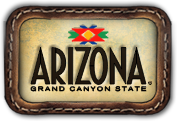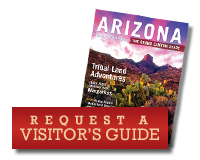-
07.04
34th Annual Prescott Rodeo Days Fine Arts & Crafts Show
more -
07.04
43rd Annual Wickenburg Fireworks & Family Fun
more -
07.04
4th of July Fireworks Show
more
-
Arizona Residents Rate
Explore what Condé Nast readers describe as one of the “World’s Best Places to Stay” right here in your own backyard.
more -
SIERRA VISTA SHUTTLE
Offering DAILY service from the Tucson International Airport with complementary meet n' greet and door to door service to your home, business or hotel in Sierra Vista and the surrounding region.
more
Archaeology
The story of Arizona can be found in its numerous well-preserved ancient ruins, fine museums, ongoing digs and thousands of artifacts that have been carefully collected and cataloged over many years of work.
You'll find engaging archaeological attractions at sites across Arizona – including many national monuments in Northern Arizona, as well as sites in both Central Arizona and Southern Arizona. In the Phoenix and Tucson areas, you'll also discover several museums and exhibitions dedicated to Arizona's archaeological past.
At some ruins, you can walk through centuries-old rooms where women cared for their children and cooked meals for their families. You can see where men made tools to hunt the region's wild animals for food. During special times of the year, other sites also open their archaeological digs to volunteer amateur archaeologists – giving you the opportunity to work and explore alongside professional staff.
Wherever you go, all year round, Arizona's archaeological wonders promise visitors of every age and interest unforgettable experiences. Start exploring Arizona's archaeology with the listings below, or visit Arizona Heritage Traveler for more information.
A word to all visitors: When you tour Arizona archaeological sites, you are visiting the homes of people who lived here thousands of years ago. Please be respectful of their homes and villages. Always stay on trails. Never pick up anything that belongs to the site or to the exhibit. And dispose of your trash properly in receptacles or bins.
-
Visit the world’s best preserved meteorite impact site just minutes from Interstate 40 in Northern Arizona near Winslow.
-
In addition to an informative exhibit about the Community, art- work by residents is showcased. Called a “museum without walls,” the collection and even archaeological excavations have been created by community members.
-
The oldest and largest anthropology museum in the state, the Arizona State Museum is a Smithsonian Institution affiliate. “Paths of Life: American Indians of the Southwest,” is the permanent exhibit and focuses on 10 tribes of Arizona and n
-
Arizona State University Museum of Anthropology
The primary emphasis is Hohokam artifacts excavated from sites around Phoenix, however the collection also includes excavations from Shoofly Village in the Payson area, sites in the Prescott region and the Colorado Plateau.
-
Casa Malpais Archaeological Park
Casa Malpais, which means “House of the Badlands”, was occupied for about 200 years and mysteriously abandoned about 1400 A.D. The Great Kiva is the centerpiece of the site and is constructed of volcanic rock.
-
Indian artifacts from the Hohokam, Apache and Yavapai are displayed in this small community museum along with exhibits about pioneer history, ranching and mining.
-
Cocopah Museum & Cultural Center
This small but intriguing museum features life-sized models of Cocopah ancestral people arranged in historic settings. The life-size dioramas illustrate the heritage of the Cocopah people who continue to reside in the Yuma area.
-
Although the park is mostly dedicated to illustrating the military history of Arizona, a self-guided, signed trail leads to a prehistoric Hohokam village called the Hardy site. The same trail also leads to some of the fort’s historic buildings.
The scope of the museum emphasizes the lifeways of indigenous people of the southwest, but the museum collection and exhibitions cover the living cultures and arts of all contemporary Native peoples.Throughout the year, the museum hosts popular events&
Exhibits tell the stories of two tribes, the Pima and the Maricopa people. Demonstrations are held of basketry and pottery making. A small outdoor dining area features homemade authentic food, including fry breadThe Hopi Cultural Center includes a small gallery museum, restaurant and an inn. Each mesa is distinctive and unique and is known for special art and craft.
Huhugam Heritage Center - Gila River Indian Community
This modern new center highlights both the historic and living cultures of the Akimel O’odham and the Pee Posh, recognizing and preserving the enduring traditions of the Gila River Indian Community.
Arizona Museum of Natural History
New exhibitions, including Origins and the hands-on Paleo Dig Pit. Come explore dinosaurs that roar and so much more!
The museum provides a wonderful introduction to the Native people who live in Northern Arizona, especially the Navajo and Hopi. There are excellent interpretive exhibits for children and a fine bookstore and gift shop that showcases art, crafts and jew
Incorporated in 1994 to conduct archaeological and historical research, Old Pueblo conducts scientific research, preservation and public interpretation projects that are open to the public. Information is available about volunteer opportunities, programs,Navajo National Monument (Keet Seel, Betatakin)
Keet Seel is built into an eye-shaped cave and accessible only by a strenuous 17-mile round trip hike and a climb up to the ruins. Betatakin is more accessible.
San Carlos Apache Cultural Center
The San Carlos Apache Tribe opened its Cultural Center to tell their own story of their people. A special exhibit, “Window on Apache Culture,” is housed in the center.
The museum is dedicated to the history of Tempe but includes an exhibit on the prehistoric Hohokam Indians who lived in the area.
On the National Register of Historic Places, Colossal Cave Mountain Park is a 2,400-acre desert park. The Park showcases Colossal Cave and La Posta Quemada Ranch, a 128-year-old working ranch.
Colossal Cave was officially "discovered" in 1879,<
Pueblo Grande Museum and Archaeological Park
Located in a 1,500 year-old Hohokam village ruin in Phoenix, the museum has been dedicated to the study and interpretation of the Hohokam culture for more than 70 years.
Adjacent to rapidly expanding communities, the 71,000-acre Agua Fria National Monument is approximately 40 miles north of central Phoenix. The monument encompasses two mesas and the canyon of the Agua Fria River. Elevations range from 2,150 feet above sea level along the Agua Fria Canyon to about 4,600 feet in the northern hills. This expansive mosaic of semi-desert area, cut by ribbons of valuable riparian forest, offers one of the most significant systems of prehistoric sites in the American Southwest. In addition to the rich record of human history, the monument contains outstanding biological resources.
Petrified Forest National Park
Experience one of the world’s largest and most vibrantly colored assemblies of petrified wood, historic structures and archeological sites at Petrified Forest National Park, located east of Winslow, Arizona. Here, 200-million-year-old fossils tell the tale of the earth – and its prehistoric inhabitants – amongst the picturesque wonders of Arizona’s Painted Desert. Petrified Forest is a surprising realm of fascinating landscape and science.
Rainbow Bridge National Monument
Rainbow Bridge is the world's largest known natural bridge. The span has undoubtedly inspired people throughout time--from the neighboring American Indian tribes who consider Rainbow Bridge sacred, to the 300,000 people from around the world who visit it each year.
Situated within rugged terrain in the northeastern part of the Sonoran Desert, these well-preserved cliff dwellings were occupied during the 13th, 14th, and early 15th centuries.



